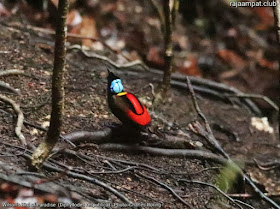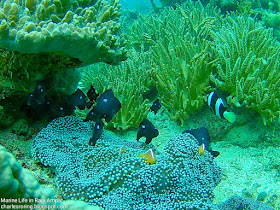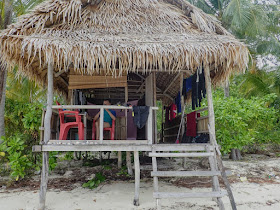The regency of Raja Ampat archipelago is located in Papua Barat province in the Republic of Indonesia. There are 4 big islands, i.e. Waigeo, Salawati, Misool and Batanta as well as hundreds of smaller tropical islands. Because the islands are located close to equator, it receives sunlight all year round. Ocean Current that flows between the Pacific Ocean and Indian Ocean through seas in Indonesia have become an ideal environment for marine life to thrive in Raja Ampat.
 |
| Coral reef in Raja Ampat |
Every year thousands of visitors from Europe, the North America, Asia, and Australia go to Raja Ampat to enjoy sightseeing, swimming, snorkeling, and scuba diving. Significant number of visitors go there to explore the biodiversity of its rainforest.
Where to stay? Most of the homestays, guesthouses and beach resorts can be found in Google Map.
When visitors go to Raja Ampat to enjoy their vacations, they will need comfortable accommodation. There are tens of guesthouses locally called "
homestay." Some in Kri island include: Yenkorano, Mangkurkodon, Turtle homestay. In Waigeo island, near Waisai town, there are Kakatua Hostel, Yendebabo, Mamatua Homestay, Wapnansan Homestay, Mandos Guesthouse, and
Yengkawe, and Yensner. West off Waigeo - in YefMo island, there is
Sea Fans Homestay
In Gam Island, there are Yensrai Homestay, Monkairi Homestay, Yenros Homestay, Yenanas Paradise Homestay, Monkairi Homestay.
For
beach resorts, along the coast of Waigeo, there are Raja Ampat Dive Resort, Scuba Republic Beach Bungalow, Hamu Eco, Gurara Dive Resort, Waiwo Dive Resort, Waigeo Villa, TPK 48, Korpak Villa and Resort, Coral Paradise Resort. In Urai island, there is Raja Ampat Doberai Eco Resort. It is not far from Raja Ampat Biodiversity Ecoresort in Gam island.
 |
| Piaynemo Karst in Raja Ampat |
Marine Life
Raja Ampat Archipelago has been famous around the world as the region that has got the richest marine biodiversity in the world. According to Wikipedia, there are 1,508 species of fish, 537 coral species, and 699 mollusk species. As more exploration of the sea of Raja Ampat is being conducted, more species of marines creatures may be found in the future. This wealth of marine biodiversity attracts thousands of recreational divers, students, and scientists to see, study and admire its beauty.
 |
| A huge table coral in Mansuar island where other corals grow on it |
Snorkeling and scuba diving is the main activity which tourists like to do when they go to Raja Ampat. There are hundreds of dive sites which they can explore.
 |
| Snorkeling in Raja Ampat |
Rainforest
Tropical rainforest that covers Raja Ampat islands are the natural habitat of a lot of species of plants, birds, insects, mammals, and reptiles. These are important attraction for visitors who like to explore the biodiversity of forest. In general green vegetation in the islands of Raja Ampat is devided into 4 types, i.e. mangrove forest, coastal forest, pseudo montane forest, and montane forest. Pseudo montane forest can be seen mostly in the slopes of most of the small islands of Raja Ampat. Since the top soil of the ground insvery thin, and the beneath it is mostly hard rocks or fossils of corals, the forest is not dense and the diameter of the trees are not big. This is different if we go deeper into the interior region of Salawati, and the mountainous regions of Waigeo, Misool and Batanta where soil layer is thicker. The trees are usually big and dense. This dense tropical rainforest that is rich in wildlife is included the zones of conservation area or nature reserve.
 |
| Red Bird of Paradise (Paradisaea rubra) |
Rainforest tours to Raja Ampat has been increasingly more popular especially among birdwatchers and wildlife photographers. Most of them take the tours to watch Red Bird of Paradise (
Paradisaea rubra) and Wilson's Bird of Paradise (
Diphyllodes respublica) as well as a lot of other tropical birds that are endemic to West Papua region.
 |
| Wilson's Bird of Paradise (Diphyllodes respublica) |
What to bring?
- Sunglasses, clothing for swimming, snorkeling or beach walk or hiking in the forest will be needed for traveling in Raja Ampat. Visitors who like marine sport activities will need snorkeling mask, snorkel and fins. For those who like to explore rainforest and observe wildlife, hiking shoes, binoculars and zoom cameras will be needed for such activities.
- Anti insect and sunblock lotions or oils.
- Traveling around hundreds of tropical islands is fun but can be challenging because of sunny weather. While doing snorkeling or sightseeing excursions by boats or on foot, visitors need to bring bottled water, biscuits or dietary supplements. Vitamin C, B6 and E are important for enhancing one's immune system.
How to get to Raja Ampat?
- If you live in, for example, Holland or Germany, you need to fly from your country to Jakarta, the capital of Indonesia.
- Continue your trip to Sorong city by taking a domestic flight provided by Garuda, Batik Air, Sriwijaya Air.
- I could meet you and organize your trip to Raja Ampat.
 |
| Raja Ampat is a regency in Indonesia |
Please, contact me (Charles Roring) by email to: peace4wp@gmail.com or whatsapp to: +6281332245180 if you want me to organize your trip to Raja Ampat and guide you to enjoy sightseeing, snorkeling and birdwatching/ rainforest tours.





























